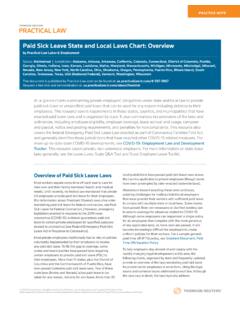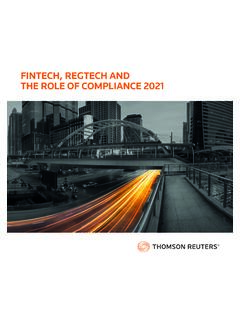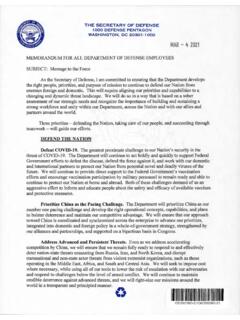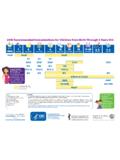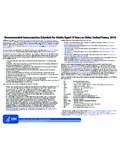Transcription of 2021 Report on the State of the Legal Market
1 2021 Report on the State of the Legal MarketTHOMSON REUTERS INSTITUTEC enter on Ethics and the Legal Profession2021 Report ON THE State OF THE Legal MARKET2 2021 Thomson Reuters. All rights Extraordinary Year Perhaps a Tipping PointTo say that the past year has been an extraordinary one for the Legal Market would be a gross understatement. The combined effects of a global pandemic, a serious economic downturn, social activism, and political uncertainty in the United States and elsewhere clearly make 2020 a year for the record books. It was a year in which law firms experienced unprecedented disruptions in their operations and were forced to adapt rapidly to dramatic Market changes. That most firms were able to adjust to these challenges with notable success is a tribute to the innovation and resiliency of law firms and their 2020 ended, however, despite recent positive reports on progress in the development of vaccines and therapeutics, uncertainty persists as to the length of the pandemic-related disruptions and how many months it is likely to be before firms can return to normal operations.
2 There is also considerable uncertainty and speculation as to what normal operations will be, even in a post-pandemic world. The latter point raises the important issue of whether 2020 may in retrospect be seen as an important inflection point for the redesign of the delivery of Legal services on a broader his best-selling book The Tipping Point,2 Malcolm Gladwell argues for a reframing of how we think about social change. Contrary to the popular assumption that social change happens slowly and steadily over a period of time, Gladwell argues with a metaphor that is eerily appropriate for our present circumstances that, in many cases, change happens more like an epidemic. As he puts it, Ideas and products and messages and behaviors spread just like viruses do. 3 That means that, while the forces of change may build up slowly, it is often a single triggering event that causes the change to take hold, and that event can be of surprising in more detail, Gladwell notes that the process of change begins with clear examples of contagious behavior , with a build-up of ideas and activities that appear to be moving in a particular direction.
3 Once the build-up reaches a certain level, the acceleration of these behaviors can be influenced by little changes that have big effects. And, at that point, change can happen very fast. The name given to that one dramatic moment in an epidemic when everything can change all at once is the Tipping Point. 41 Thomson Reuters Peer Monitor data are based on reported results from 162 law firms, including 45 Am Law 100 firms, 56 Am Law Second 100 Firms, and 61 additional Midsize Malcolm Gladwell, The Tipping Point How Little Things Can Make a Big Difference (2000).3 Id. at Id. at Center on Ethics and the Legal Profession at the Georgetown University Law Center and Thomson Reuters Institute are pleased to present this 2021 Report setting out our views of the dominant trends that impacted the Legal Market in 2020 and key issues likely to influence the Market in 2021 and beyond.
4 Supporting data for this Report have been provided by Peer Monitor 1 and Acritas, both parts of Thomson Report ON THE State OF THE Legal MARKET3 2021 Thomson Reuters. All rights From 2007 to 2020, average worked (or agreed) rates for law firm services rose by some 40 percent from $374 to $523 per hour, or just short of 3 percent per year. Source: Thomson Reuters Peer Monitor .6 Average law firm direct expenses grew at a rate of some 18 percent in 2008, while overhead expenses grew at around 10 percent. By the end of 2019 (before the beginning of the pandemic), direct expense growth had fallen to percent and overhead growth had dropped to percent. Source: Thomson Reuters Peer Monitor . For these purposes, direct expenses refer to those expenses related to fee earners, primarily the compensation and benefits costs of lawyers and other timekeepers. Overhead (or indirect) expenses refer to all other expenses of the firm, including occupancy costs, administrative and staff compensation and benefits, technology costs, recruiting costs, business development costs, and the During 2018 and 2019, law firms experienced average revenue growth of and percent, respectively.
5 Source: Thomson Reuters Peer Monitor . 8 For our purposes, demand for law firm services is viewed as the equivalent of total billable hours recorded by law firms during a specified these insights to the Legal Market in 2020 can be instructive. For the past decade (since the Great Recession), the Market for Legal services has been evolving toward a different delivery model. The evidence of that evolution has been visible in the changing role and expectations of clients, changes in the pricing of law firm services, growth of competition (including from non-traditional law firms), and changes in technology. Combined, these trends or as Gladwell might describe them, these clear examples of contagious behavior have been pushing the Market toward making the delivery of Legal services more efficient, more predictable, and more cost effective. And they have been driving a new Market reality in which law firms are no longer solely in control of their own many firms have implemented significant changes in response to these Market forces, unfortunately many others have not.
6 Although frequently embraced by law firm senior management, the stumbling block to real change has most often been law firm partners themselves, who have resisted trying new approaches for a variety of reasons. Arguably, the COVID-19 pandemic has exacerbated and accelerated all of these trends and even added some new ones. The question is whether the combined effects of the pandemic may have softened partner resistance to fundamental change enough to create a tipping point in the pressures building for a significant redesign of our Legal delivery systems including law firms. As we describe in the sections that follow, evidence suggests that it well might have done of Law Firm Performance in 2020 Following the jolt of the Great Recession and the initial recovery from it (2007-2010), the Market for law firm services performed reasonably well for a decade. During this period, law firms were able to maintain profitability at acceptable levels ( , at levels that enabled them to remain competitive in the changed Market ) primarily by (i) fairly aggressively increasing rates;5 (ii) increasing leverage by shrinking the ranks of equity partners while growing other categories of fee earners; and (iii) aggressively controlling above-described tactics led to particularly good financial performance across the Market in 2018 and 2019,7 and that performance continued into the first two months of 2020.
7 Beginning in March, however, as the COVID-19 crisis began to spread, the picture changed dramatically. This can be seen quite clearly in Figure 1 on page 4 that shows the average daily demand for law firm services8 per lawyer on a month-by-month basis in 2020 as compared to the averages for 2018 and 2019. As shown, while the average daily demand figures tracked the prior two-year averages fairly closely in January and February, they began to diverge significantly during March. Further, as shown in Figure 2, the drop off in demand that began in March has affected virtually all law firm practices, with the notable exception of bankruptcy and reorganization work. To provide a sense of the extent of the demand decline during the pandemic, Figure 3 shows the average daily demand per lawyer on a YTD basis for 2020 as compared to 2018 and 2019, broken out by Market segment.
8 The stumbling block to real change has most often been law fi rm partners themselves, who have resisted trying new approaches for a variety of reasons. 2021 Report ON THE State OF THE Legal MARKET4 2021 Thomson Reuters. All rights 2 Demand Growth by PracticeFigure 1 Average Daily Demand per Lawyer by 28%Patent 4% 2%All timekeepersBillable time type; non-contingent 11%Corporate (All) 25% 3%Real 7%2020 v. 2019 Change(YTD Nov.)Patent 5%Source: Thomson Reuters Peer Monitor (contractors excluded)Billable time type; non-contingent mattersJanFebMarMayJunAugJulSepAprOctSou rce: Thomson Reuters Peer Monitor DecNovAvg. Daily Demand (hrs) per FTE2-Year Average (2018 & 2019) 20202021 Report ON THE State OF THE Legal MARKET5 2021 Thomson Reuters. All rights 3 Average Daily Demand per Lawyer by Market SegmentInterestingly, the drop in demand experienced by law firms was not shared by clients.
9 In an Acritas survey of senior in-house counsel, a substantial majority reported a surge in workload resulting from the pandemic. Much of this work involved novel issues that had to be handled by in-house counsel themselves as it required an in-depth knowledge of their businesses and a very quick turnaround. As a result, some of the business as usual Legal work of their departments including many transactions and litigation matters had to be put on hold. This contributed to the drop in demand for law (contractors excluded)Billable time type; non-contingent mattersPercentages represent percent change from YTD Nov. 2019 to YTD Nov. 2020 Source: Thomson Reuters Peer Monitor All FirmsAm Law 100Am Law Second Daily Demand (hrs) per FTE YTD Nov. 2018 YTD Nov. 2019 YTD Nov. Thomson Reuters Legal Tracker, Legal Department Operations (LDO) Index (Fifth Edition, 2020) (the LDO Index ), at Report ON THE State OF THE Legal MARKET6 2021 Thomson Reuters.
10 All rights v Worked (Agreed)88% 89% 90% 91% 92% 93% 94% 95% 2007200820092010201220132015201420162011 20172018 YTD 2019 Source: Thomson Reuters Peer Monitor Lawyers (contractors excluded) Billable time type; non-contingent mattersAs indicated in Figures 4 and 5, despite the downturn in demand, most firms were still able to increase their rates during 2020, though realization dropped somewhat. These increases were made possible in part by the fact that most of them were implemented prior to the end of 2019, before the spread of the pandemic in the United States began. Since March, many firms have also focused special attention on billing and collection efforts, with the result that (at least in larger firms) there have been significant improvements in practices such as daily time recording, weekly time reviews, timely billings, follow-ups on client payment delays, and closer scrutiny of expected collections and potential 4 Lawyer Rate Progression11 Figure 5 Collection Realization against Worked (Agreed) RatesSource: Thomson Reuters Peer Monitor Lawyers (contractors excluded) Billable time type; non-contingent mattersStandardWorked (Agreed)BilledCollected$300 $350 $400 $450 $500 $550 2007200820092010201220132015201420162011 20172018$575 $325 $375 $425 $475 $525 $600 YTD 201910 Gretta Rusanow, Head of Advisory Services, Law Firm Group, Citi Private Bank, Remarks at The 19th Annual Law Firm COO & CFO Forum (Oct.)
